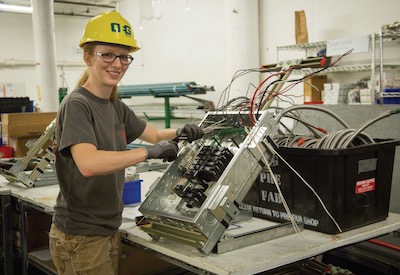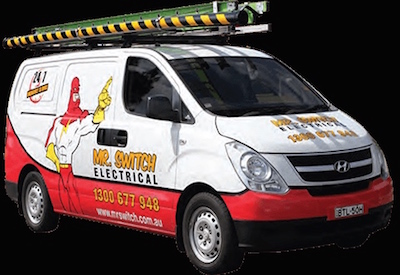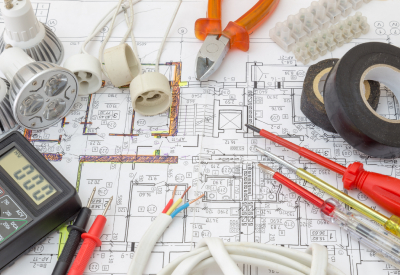Powered Hand Tools — Electric Tools — Basic Safety

July 12, 2020
Appearing below is a fact sheet on electrical tool safety compiled by the Canadian Centre for Occupational Health and Safety (CCOHS).* This is one of many easy-to-read, question-and-answer fact sheets covering a wide range of workplace health and safety topics, from hazards to diseases to ergonomics to workplace promotion.
When and how should you inspect powered hand tools?
• Inspect tools for any damage prior to each use.
• Check the handle and body casing of the tool for cracks or other damage.
• If the tool has auxiliary or double handles, check to see that they installed securely.
• Inspect cords for defects: check the power cord for cracking, fraying, and other signs of wear or faults in the cord insulation.
• Check for damaged switches and ones with faulty trigger locks.
• Inspect the plug for cracks and for missing, loose or faulty prongs.
What should you do if you find a tool defective?
• If a tool is defective, remove it from service, and tag it clearly “Out of service for repair”.
• Replace damaged equipment immediately – do not use defective tools “temporarily”.
• Have tools repaired by a qualified person – do not attempt field repairs.
What should you do before using powered hand tools?
• Ensure that you have been properly trained to use the tool safely. Read the operator’s manual before using the tool and operate the tool according to the manufacturer’s instructions. Use only tested and approved tools.
• Ensure that the power tool has the correct guard, shield or other attachment that the manufacturer recommends.
• Prevent shocks. Ensure that the tools are properly grounded using a three-prong plug, are double-insulated (and are labelled as such), or are powered by a low-voltage isolation transformer: this will protect users from an electrical shock.
• Check electric tools to ensure that a tool with a 3-prong plug has an approved 3-wire cord and is grounded. The three-prong plug should be plugged in a properly grounded 3-pole outlet. If an adapter must be used to accommodate a two-hole receptacle, the adapter wire must be attached to a known, functioning ground. NEVER remove the third, grounding prong from a plug.
• Replace open front plugs with dead front plugs. Dead front plugs are sealed and present less danger of shock or short circuit.
• Have a qualified electrician install a polarized outlet if the polarized, two-prong plug of a double-insulated tool does not fit in a two-hole receptacle. Double insulated tools use plugs having one prong that is visibly wider than the other.
• Test all tools for effective grounding with a continuity tester or a ground fault circuit interrupter (GFCI) before use.
• Use only the kind of battery that the tool manufacturer specifies for the battery-powered tool that you are using.
• Recharge a battery-powered tool only with a charger that is specifically intended for the battery in that tool.
• Remove the battery from the tool or ensure that the tool is switched off or locked off before changing accessories, making adjustments, or storing the tool.
• Store a battery pack safely so that no metal parts, nails, screws, wrenches and so on can come in contact with the battery terminals; this could result in shorting the battery and possibly cause sparks, fires or burns.
What should you do while using powered hand tools?
• Wear or use personal protective equipment (PPE) or clothing that is appropriate for the work you are doing; this may include items such as safety glasses or goggles, or a face shield (with safety glasses or goggles), hearing protection, dust mask, gloves, safety boots or shoes, or rubber boots.
• Switch off the tools before connecting them to a power supply.
• If a power cord feels more than comfortably warm or if a tool is sparking, have it checked by an electrician or other qualified person.
• Disconnect the power supply before making adjustments or changing accessories.
• Remove any wrenches and adjusting tools before turning on a tool.
• Inspect the cord for fraying or damage before each use. Tag defective tools clearly with an “Out of service” tag and replace immediately with a tool in good running order.
• During use, keep power cords clear of tools and the path that the tool will take.
• Use clamps, a vice or other devices to hold and support the piece being worked on, when practical to do so. This will allow you to use both hands for better control of the tool and will help prevent injuries if a tool jams or binds in a work piece.
• Use only approved extension cords that have the proper wire size (gauge) for the length of cord and power requirements of the electric tool that you are using. This will prevent the cord from overheating.
• For outdoor work, use outdoor extension cords marked “W-A” or “W”.
• Suspend power cords over aisles or work areas to eliminate stumbling or tripping hazards.
• Eliminate octopus connections: if more than one receptacle plug is needed, use a power bar or power distribution strip that has an integral power cord and a built-in overcurrent protection.
• Pull the plug, not the cord when unplugging a tool. Pulling the cord causes wear and may adversely affect the wiring to the plug and cause electrical shock to the operator.
• Follow good housekeeping procedures – keep the work area free of clutter and debris that could be tripping or slipping hazards.
• Keep power cords away from heat, water, oil, sharp edges and moving parts. They can damage the insulation and cause a shock.
• Ensure that cutting tools, drill bits, etc. are kept sharp, clean and well maintained.
• Store tools in a dry, secure location when they are not being used.
What should you avoid when using powered tools?
• Do not wear gloves, loose clothing or jewelry while using revolving power tools. Tie back long hair or wear appropriate hair protection to prevent hair from getting caught in moving parts of equipment.
• Do not use a tool unless you have been trained to use it safely and know its limitations and hazards.
• Avoid accidental starting by ensuring the tool is turned off before you plug it in. Also do not walk around with a plugged-in tool with your finger touching the switch.
• Do not bypass the ON/OFF switch and operate the tools by connecting and disconnecting the power cord.
• Do not disconnect the power supply of the tool by pulling or jerking the cord from the outlet.
• Do not leave a running tool unattended. Do not leave it until it has been turned off, has stopped running completely, and has been unplugged.
• Do not use electric tools in wet conditions or damp locations unless tool is connected to a ground fault circuit interrupter (GFCI).
• Do not expose electric power tools to rain or wet conditions; wet tools increase the likelihood of electric shock.
• Avoid body contact with grounded surfaces like refrigerators, pipes and radiators when using electric powered tools; this will reduce the likelihood of shock if the operator’s body is grounded.
• Do not plug several power cords into one outlet by using single-to-multiple outlet adapters or converters (“cube taps”).
• Do not use light duty power cords.
• Stop using an electric power tool if you feel a tingle in your fingers. This is a warning that the tool is faulty and needs repair.
• Do not connect or splice extension cords together to make a longer connection: the resulting extension cord may not be able to provide sufficient current or power safely.
• Do not carry electrical tools by the power cord.
• Do not tie power cords in knots. Knots can cause short circuits and shocks. Loop the cords or use a twist lock plug.
• Never break off the third prong on a plug: replace broken 3-prong plugs and make sure the third prong is properly grounded.
• Never use extension cords as permanent wiring: use extension cords only as a temporary power supply to an area that does not have a power outlet.
• Do not walk on or allow vehicles or other moving equipment to pass over unprotected power cords. Cords should be put in conduits or protected by placing planks on each side of them.
• Do not brush away sawdust, shavings or turnings while the tool is running. Never use compressed air for cleaning surfaces or removing sawdust, metal turnings, etc.
• Do not operate tools in an area containing explosive vapours or gases.
• Do not clean tools with flammable or toxic solvents.
• Do not surprise or touch anyone who is operating a tool. Startling a tool operator could end up causing an accident or injury.
* The Canadian Centre for Occupational Health and Safety (CCOHS) is governed by a tripartite Council — representing government, employers and labour — to ensure a balanced approach to workplace health and safety issues. CCOHS offers a range of workplace health and safety services to help workplaces raise awareness, assess risks, implement prevention programs, and improve health, safety and well-being.
Photo curtesy of the Western Resources Center for Women in Apprenticeship’s Tradeswomen Image Library. Find out more about the centre: http://womeninapprenticeship.org
















